Amylase Serum and Acute Pancreatitis Diagnosis
Amylase
Sample for Amylase Serum
- This test is done in the serum of the patient.
- The serum is stable at room temp, for 7 days and at 4 °C for one month.
- Take 3 to 5 ml of blood in the disposable syringe. Keep the syringe for 15 to 30 minutes and then centrifuge for 2 to 4 minutes. In this way, you can get a clear serum.
Precautions for Amylase Serum
- Avoid alcohol intake before sampling because it gives rise to an increase in the amylase level.
- Urine can be collected at 2 hours or 24 hours sample. Refrigerate the urine.
- Avoid contamination with saliva.
- Lipemia interferes with the reading of the result.
- Anticoagulant EDTA, fluoride, oxalate, and citrate decreased amylase levels. These anticoagulants bind the calcium ions.
Purpose of the test (Indications) for Amylase Serum
- To diagnose acute pancreatitis and monitor the treatment.
- To differentiate other abdominal pain, epigastric discomfort, nausea, and vomiting.
- In the case of ascites, it may be done to rule out pancreatitis.
Classification of amylase:
- Serum Amylase primarily consists of salivary glands (S – type) and pancreas (p-type) isoenzymes.
- Amylase exists in two isoenzyme forms:
- P – amylase is 40% of the total and is found in the pancreas.
- S – amylase is 60% of the total and is found in the salivary glands, ovary, fallopian tubes, bronchial epithelium, testes, and intestine.
- α-Amylase is found in humans.
- β-Amylase is found in bacteria and plants.
- Both types may be increased in renal insufficiency.
Amylase synthesis:
- Amylase is the smallest enzyme with a molecular weight of 50,000 to 55,000.
- Because of its small size, it is filtered through the glomeruli and appears in the urine.
- This enzyme is synthesized in the pancreas and salivary glands. Amylase is secreted into the gastrointestinal tract, where it helps to digest starch and glycogen in the mouth, stomach, and intestine.
- Serum amylase consists of:
- Salivary gland amylase is S-type.
- Pancreatic amylase is P-type.
- Serum amylase consists of:
- Amylase is normally secreted from the pancreatic acinar cells into the pancreatic duct and then into the duodenum.
- Once in the intestine, it helps in the catabolism of carbohydrates and starch to simple sugars.
- Amylase activity is low in the infant’s blood for the first 2 months of life and reaches the adult level by one year.
- Amylase high activity is seen in Pancreas and parotid gland.
- Once there is damage to pancreatic acinar cells, amylase outpours into the peritoneum and is absorbed by the blood and lymph.
Clinical significance of Amylase Serum:
- Amylase activity in the blood is low and constant, increasing in acute pancreatitis and salivary gland inflammations.
- Its main clinical significance is in the following:
- P-amylase is raised in Pancreatic lesions like:
- Acute pancreatitis.
- Biliary tract diseases like cholecystitis give rise to an increase up to 4 times the normal.
- It is raised in the intraabdominal lesion and maybe 4 times the normal value.
- Acute appendicitis and peritonitis slightly increase P-amylase; this may be 2 to 3 times the normal.
- In renal insufficiency, P-amylase is increased according to the renal lesion and usually not >5 times the normal.
- Amylase may be increased in neoplastic diseases and may be high up to 50 times the normal.
- S-amylase is raised in salivary glands lesions like:
- Infections of the salivary glands.
- Radiation of the salivary glands.
- If there is an obstruction to the drainage.
- After the surgery of the salivary glands.
- Tumors of the salivary glands.
- It is found raised in 80% of diabetic ketoacidosis cases.
- 10% of alcoholics with alcoholic intoxication may raise levels to 3 times the normal.
- Some drugs may give rise to hyperamylasemia.
Amylase In the case of acute pancreatitis:
- Amylase increases in the first 3 to 6 hours (another reference for 2 to 12 hours) after the onset of the symptoms.
- The maximum level (peak) is 20 to 30 hours (another reference is 12 to 72 hours).
- Fall to normal within 48 to 72 hours (3 to 5 days).
- It may increase to 40 times normal; the level may vary from 250 to 1000 Somogyi units/dL.
- The level may go much higher than the above value.
- In case of a persistent level of more than 5 days, it suggests a complication like a pseudocyst.
Normal Amylase level
The value may vary from lab to lab.
- Adult = 30 to 220 U/L.
- Newborn = 6 to 65 U /L
Another source:
- Newborn = 5 to 65 U/L
- Adult = 27 to 131 U/L
- Adult 60 to 90 years = 24 to 151 U/L
Source 2
- Serum
- Adult = 60 to 120 Somogyi unit/dL
- Values may increase during pregnancy.
- Values may increase in older adults.
- Urine 24 hours
- Up to 5000 Somogyi units/24 hours
Another source:
- Amylase serum = 25 to 130 U/L
- Amylase urine = 1 to 15 U/L
- Conversion factor = Somogyi unit to International unit = 1.85
Critical values
- More than three times the upper limit of the normal.
- >200 U/L.
Lab diagnosis of Acute Pancreatitis:
- Rise starts in 2 to 12 hours.
- The peak level reaches 12 to 72 hours.
- The normal level reaches 3 to 4 days.
- 10% of the cases of acute pancreatitis are associated with a normal level of amylase.
- Sensitivity is lowest in chronic relapsing and alcoholic pancreatitis.
- 30% of the cases are due to non-pancreatic causes like:
- Diabetic ketoacidosis.
- Acute cholecystitis.
- Peptic ulcers.
- Salpingitis.
- Ectopic pregnancy.
- Intestinal ischemia.
- Intestinal obstruction.
- Renal insufficiency.
- Macromylasemia.
- For diagnosis of acute pancreatitis:
- Amylase is 3 times the normal with a specificity of 95% and sensitivity of 60 to 80%.
- There is an increase in the pancreatic isoenzymes of amylase (also increased in the pancreatic pseudocyst).
- Salivary type of amylase is found in esophageal rupture, peptic ulcer, necrosis of the small intestine, and 10% of metastatic cancer.
- Lipase is also 3 times the normal, with specificity and sensitivity of 90% each.
- The pleural fluid/serum amylase ratio may be normal early and increase over time.
Ranson criteria for the prognosis and mortality of acute pancreatitis:
These points are added based on the following clinical and laboratory findings.
| Parameters | Negative (at admission) | Positive (within 48 hours) |
| Age of the patient >55 years | 0 | 1 |
| WBC count >16,000/cmm | 0 | 1 |
| Glucose >200 mg/dL | 0 | 1 |
| AST >250 IU/L | 0 | 1 |
| LDH >350 IU/L | 0 | 1 |
| BUN >5 mg/dL (after 48 hours) | 0 | 1 |
| HCT decrease >10% (after 48 hours) | 0 | 1 |
| Calcium <8 mg/dL (after 48 hours) | 0 | 1 |
Interpretations of Ranson criteria:
- A score of 3 or 4 indicates severe acute pancreatitis.
- The scoring in ICU was applied within 24 hours of admission.
- Some of the ICUs advise more tests and parameters like:
- paO2 = <60 mm Hg at 48 hours.
- Base deficit = >4 meq/L at 48 hours.
- Fluid sequestration = >6L at 48 hours.
Amylase: creatinine (A/Cr) clearance ratio:
- This test can be done on a random sample of blood and urine. There is no need to collect 24-hour urine samples.
- Amylase secretion by the kidneys depends upon renal functions.
- Amylase urinary excretion correlates with creatinine clearance.
- A/Cr becomes abnormal 1 to 2 days after the elevation of the serum amylase, but it remains abnormal for about as long as urinary amylase.
- Some people believe 90% sensitivity for acute pancreatitis.
- A/Cr is more specific for pancreatitis than changes in the serum amylase level.
Amylase increased level is seen in the following:
- Acute Pancreatitis and Acute exacerbation of chronic Pancreatitis.
- Pancreatic cyst and pseudocyst.
- Acute alcoholic poisoning.
- Salivary glands diseases like mumps, duct obstruction, or parotitis.
- Maybe in acute cholecystitis or intestinal obstructions.
- Increased obstruction of the common bile duct, pancreatic duct, or ampulla of Vater.
- Ruptured Ectopic Pregnancy.
- Renal failure due to reduced excretion by the kidneys.
- Diabetic ketoacidosis.
- In peritonitis.
- In some of the lungs and ovarian tumors.
- Alcohol intake.
- It may be seen in abdominal trauma, head injury, viral infections, and postoperative patient.
Amylase level Decreased in:
- Extensive marked destruction of the pancreas, e.g., Acute Fulminant Pancreatitis.
- Chronic Pancreatitis and pancreatic cancer.
- In pancreatectomy.
- Cirrhosis and severe liver diseases like hepatitis.
- Perforating or penetrating peptic ulcers.
- Toxemia of pregnancy.
- Advanced cystic fibrosis.
Amylase may be normal:
- Relapsing chronic pancreatitis.
- Frequently normal in acute alcoholic pancreatitis.
- Technical problem in case of hypertriglyceridemia. It interferes with the estimation.
Important facts
- An elevated serum amylase level is not a specific test because a disorder other than the pancreas produces amylase elevation.
Questions and answers:
Question 1: What is the significant level of amylase to diagnose acute pancreatitis?
Question 2: What is the critical value of amylase?

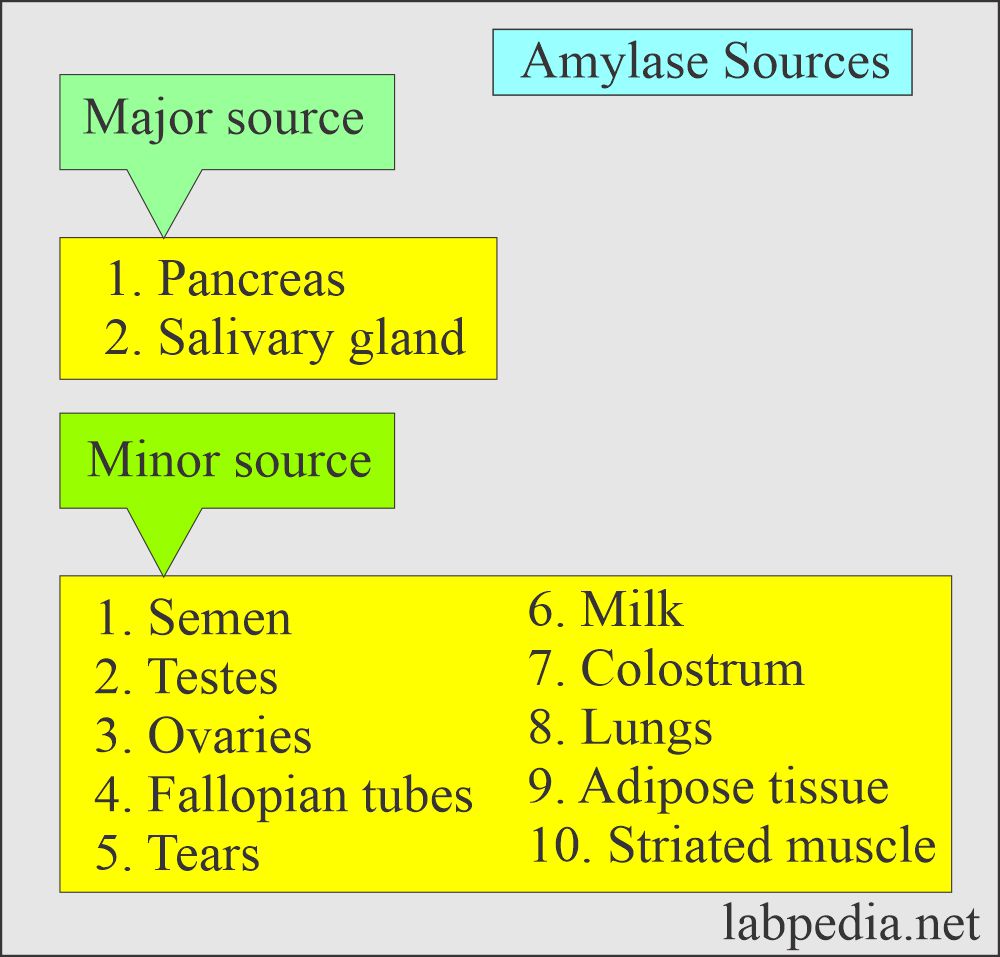
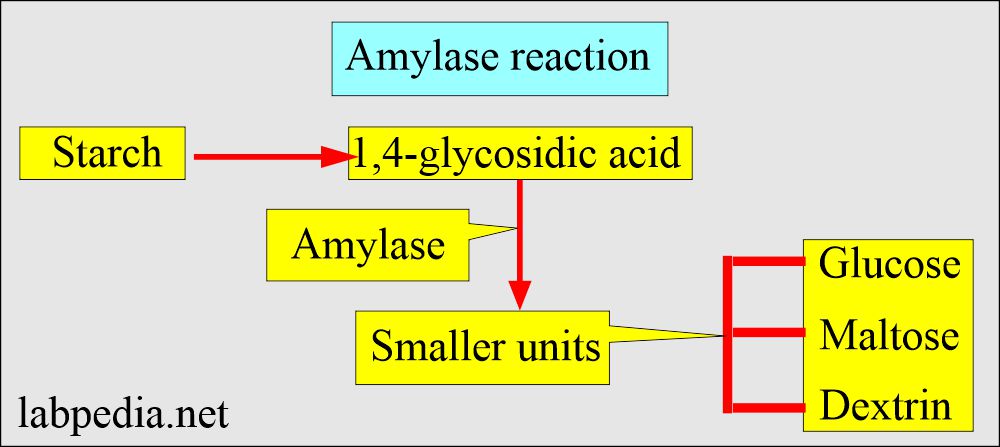
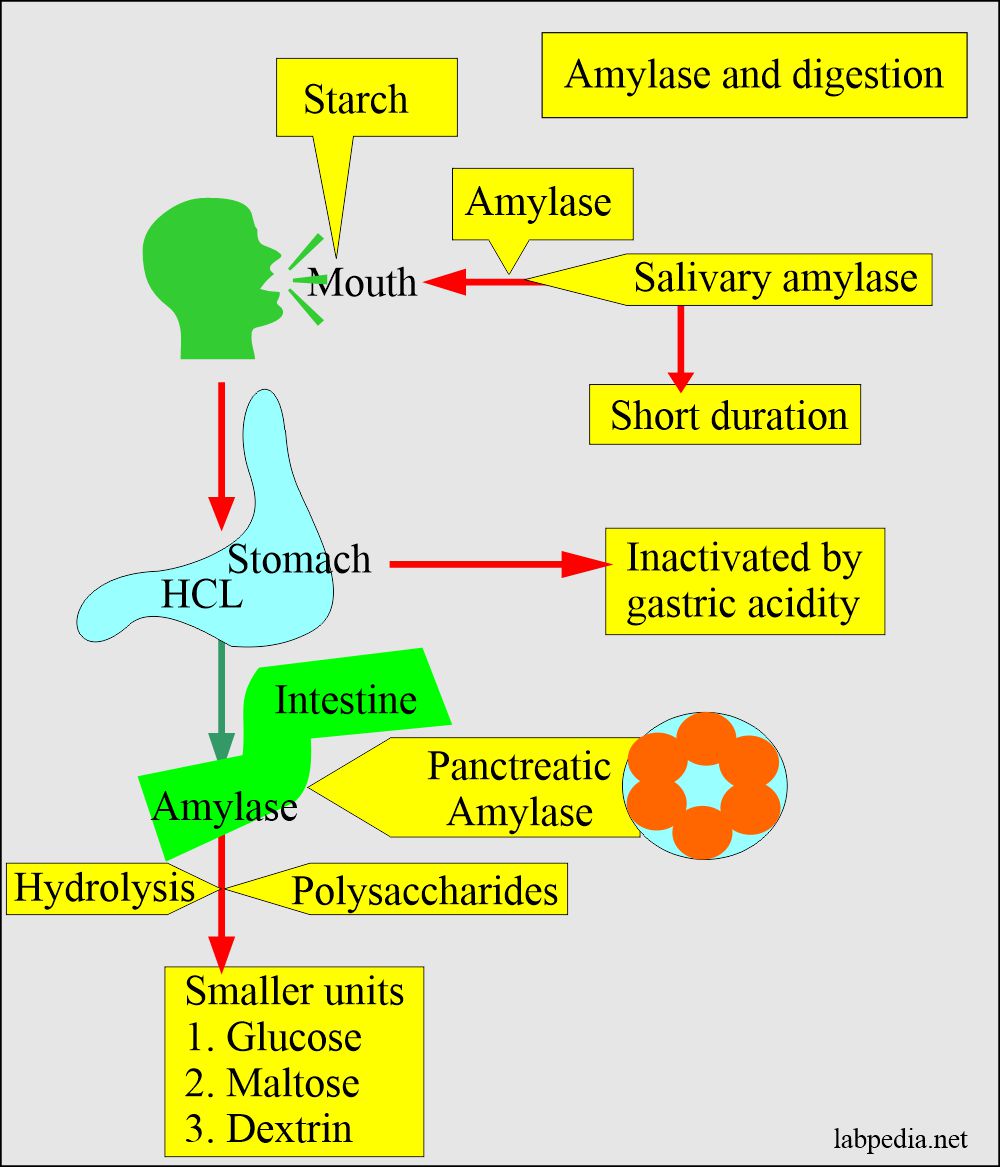
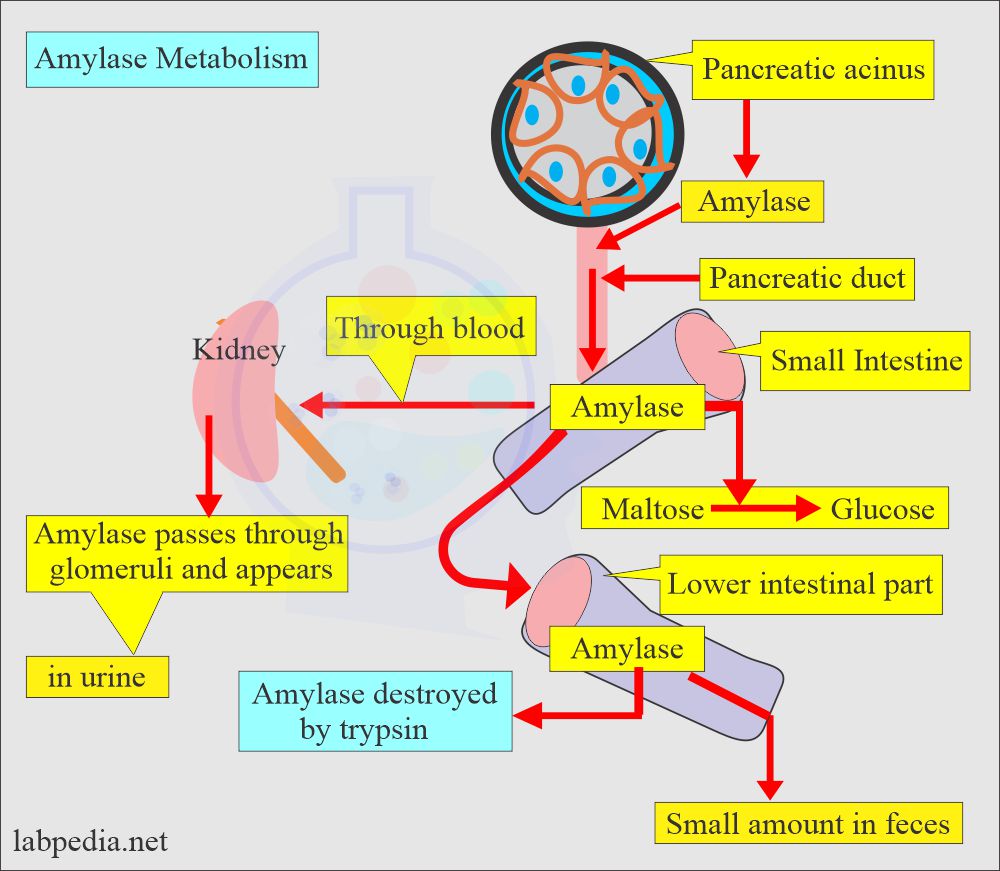
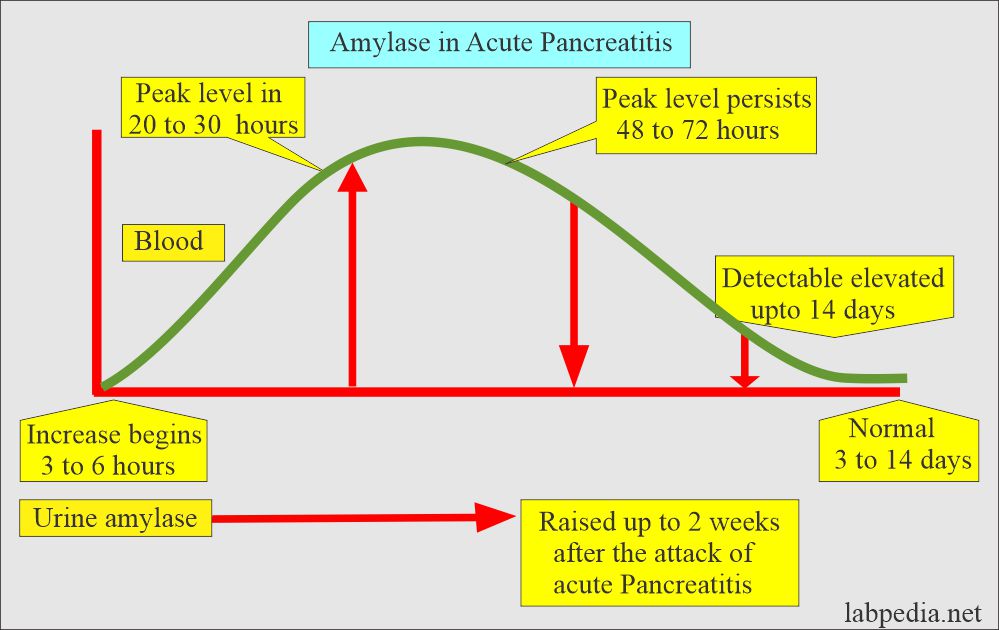
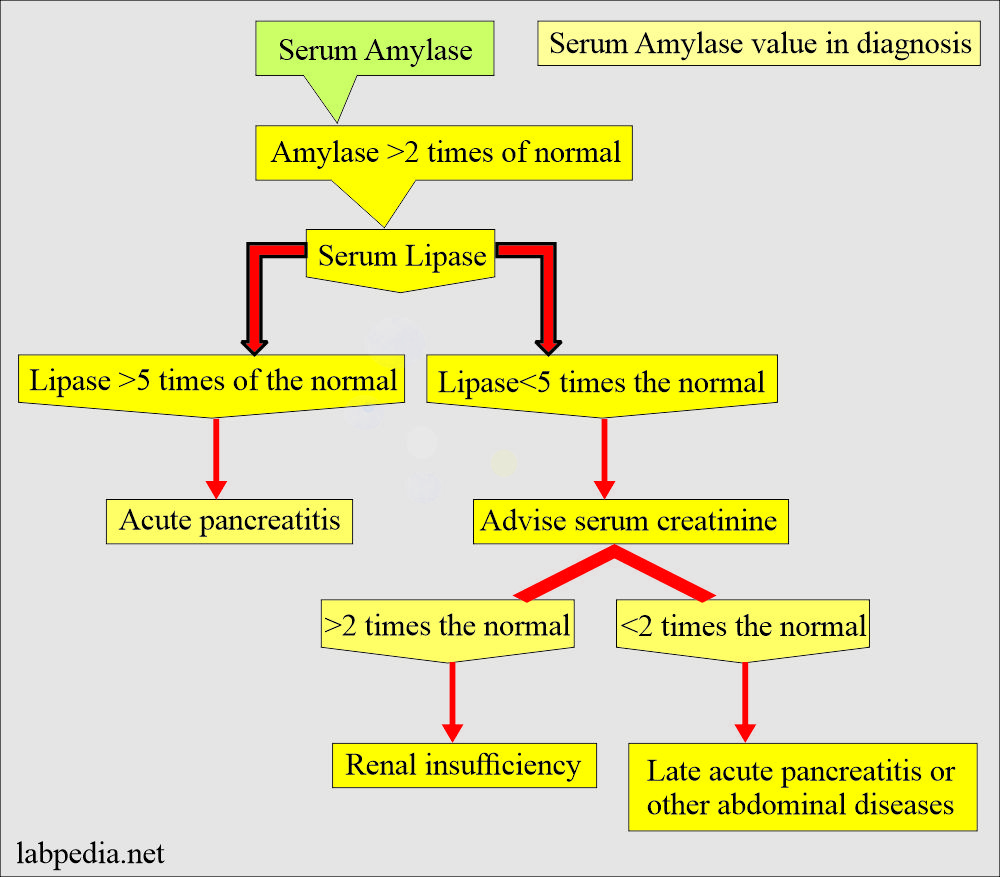
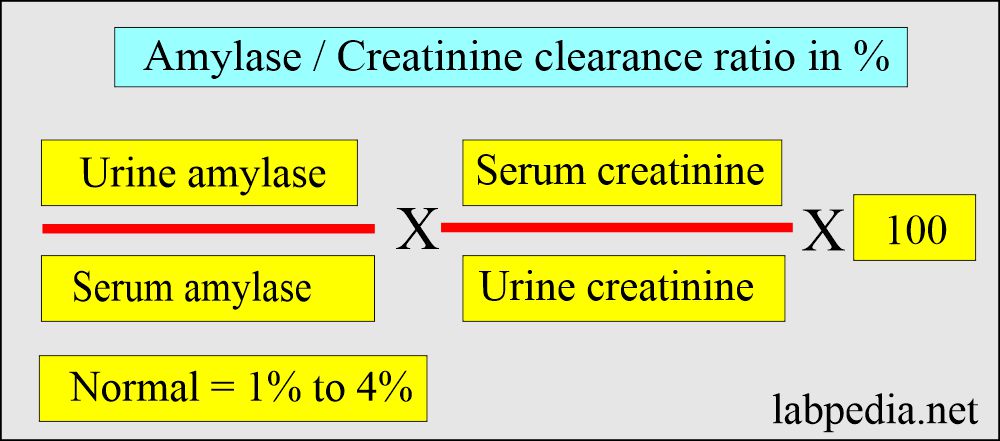
Bio chemistry
Clinal